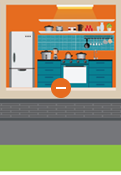Attic, Garage and Unconditioned Spaces
There are many unconditioned spaces in your home – attic, garage, utility room, etc. – which often get overlooked for energy-efficient and conservation measures. Let’s see what we can dig up!
Office and Electronics
In this digital age, electronics are found in every room of the house and many of them have energy-efficient settings. Check out our list below for more information.
Bedroom
Even while you sleep, your home can still use energy. Below we have outlined some tips on saving electricity and staying comfortable without breaking the bank.
Bathroom
This may not be a hot spot for energy efficiency, but there are ways to conserve energy without sacrificing comfort. Check those out below.
Living Room
From lighting to windows to your thermostat, the living room is a great place to make the most out of home energy savings. Read on to see how to reduce electricity bills in your main living space.
Miscellaneous
There are many more ways you can save energy that don’t necessarily fit into one particular room. We have you covered with more tips below.
Kitchen
Even with energy-efficient appliances, you can still learn how to save money on electric bills with the helpful tips you’ll find below.
HVAC – Heating, Ventilation and Air Conditioning
The majority of your energy usage comes from your HVAC system. Below we have outlined numerous tips to help you stay comfortable and maintain your system while lowering your utility bills.
ALL ABOUT HEAT PUMPS
Learn about the new technology making home comfort even more efficient with our video on Heat Pumps.
Heat Pump Basics
- Air-source heat pumps transfer warm/cool air between the outdoors and your home to help warm your home.
- Geothermal heat pumps use consistent ground temperatures to help heat and cool a home via buried, solution-filled or well water-filled pipes.
Air-Source Heat Pumps
Air-source heat pumps (ASHP) are most common. ASHPs operate very similarly to an air-conditioner, but in reverse.
- Reversing valves allow the coils to either cool or warm homes by moving molecules from one space to another – in the winter, warmer air molecules transfer into your home from outside; in the summer, warm molecules are removed from the indoors, leaving only cold air molecules.
- Much like traditional air-conditioners, most ASHPs are centralized, with ductwork distributing the conditioned air.
- Some ductless room-unit/mini-split ASHPs connect to an outdoor heat-pump instead of a centralized unit to heat/cool rooms directly.
- ASHP systems run most efficiently with an outdoor thermostat. This runs the HP first before automatically switching over to 2nd-stage heating (your furnace). If your home has an electric furnace, this reduces electricity costs in addition to keeping you comfy.
- The outdoor thermostat system should be set between 35 and 40 degrees, which will let the system know when to let your furnace help maintain comfort.
- ASHPs deliver heat energy more efficiently than electric or natural gas furnaces because they transfer heat instead of converting heat from fuel.
- Some, but not all, newer ASHPs can operate in this region of the US without a backup/emergency heating source like a furnace. This, however, is uncommon.
Geothermal Heat Pumps
Instead of moving air to adjust the air temperature, geothermal heat pumps (GHPs) tap into the consistently cooler temperatures of underground soil or water sources like wells.
- Most GHPs are ground-source (closed-loop geothermal pumps) units.
- Water source units use a water mixture inside underground pipes, which is circulated to cool or heat indoor environments.
- GHP’s indoor coils move heat out of the circulating water and into your home’s air.
- Because they run at relatively lower temperatures than furnaces, GHPs work best in well-insulated, air-tight, energy-efficient homes.
- GHPs are more efficient than ASHPs due to the temperate and consistent temperature of the ground soil, however, GHPs are much more expensive to buy/install compared to ASHPs.
Efficient doesn’t always mean “cheaper”! Energy efficiency relates to the efficiency in converting one form of energy to another when warming or cooling a space.
Electric furnaces produce heat at 100% efficiency (no energy is lost in the transfer of electricity to thermal energy) but the energy required to generate heat costs more than less-efficient (80-95%) natural-gas furnaces. Heat pumps may be designed more efficiently, but it may still be cheaper to heat your home with a natural gas furnace depending on the comparative fuel costs.


















